| |||||
| Decades: | |||||
|---|---|---|---|---|---|
| See also: | |||||
This article lists events that occurred during 1950 in Estonia .
| |||||
| Decades: | |||||
|---|---|---|---|---|---|
| See also: | |||||
This article lists events that occurred during 1950 in Estonia .
31 July – Olav Ehala, composer

The October Revolution, officially known as the Great October Socialist Revolution in the former Soviet Union, also known as the Bolshevik Revolution, was a revolution in Russia led by the Bolshevik Party of Vladimir Lenin that was a key moment in the larger Russian Revolution of 1917–1923. It was the second revolutionary change of government in Russia in 1917. It took place through an armed insurrection in Petrograd on 7 November 1917 [O.S. 25 October]. It was the precipitating event of the Russian Civil War.

Baltic Germans were ethnic German inhabitants of the eastern shores of the Baltic Sea, in what today are Estonia and Latvia. Since their coerced resettlement in 1939, Baltic Germans have markedly declined as a geographically determined ethnic group. However, it is estimated that several thousand people with some form of (Baltic) German identity still reside in Latvia and Estonia.

The anthem of the Estonian SSR was the Soviet regional anthem of the Estonian SSR between 1945 and 1990 when Estonia was occupied by the Soviet Union.

Narva is a municipality and city in Estonia. It is located in the Ida-Viru County, at the eastern extreme point of Estonia, on the west bank of the Narva river which forms the Estonia–Russia international border. With 53,626 inhabitants Narva is Estonia's third largest city after capital Tallinn and Tartu.

Crime in Estonia is combated by the Estonian police and other agencies.
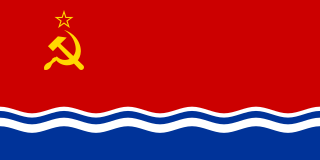
The Latvian Soviet Socialist Republic, also known as Soviet Latvia or simply Latvia, was a republic in the Soviet Union. The Latvian SSR existed for over 50 years, from 5 August 1940 to 6 September 1991.

Harju County, is one of the fifteen counties of Estonia. It is situated in Northern Estonia, on the southern coast of the Gulf of Finland, and borders Lääne-Viru County to the east, Järva County to the southeast, Rapla County to the south, and Lääne County to the southwest. The capital and largest city of Estonia, Tallinn, is situated in Harju County. Harju County is the largest county in Estonia in terms of population, as almost half (45%) of the Estonia's population lives in Harju County.
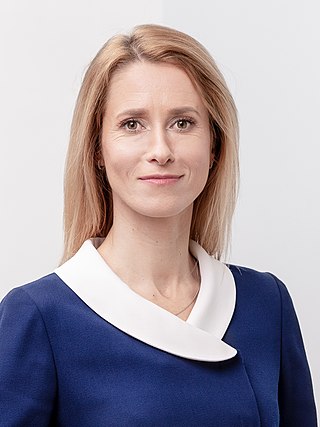
The prime minister of Estonia is the head of government of the Republic of Estonia. The prime minister is nominated by the president after appropriate consultations with the parliamentary factions and confirmed by the parliament (Riigikogu). In case of disagreement, the Parliament can reject the president's nomination and choose their own candidate. In practice, since the prime minister must maintain the confidence of Parliament in order to remain in office, they are usually the leader of the senior partner in the governing coalition. The current prime minister is Kaja Kallas of the Reform Party. She took the office on 26 January 2021 following the resignation of Jüri Ratas.

The Baltic Way or Baltic Chain was a peaceful political demonstration that occurred on 23 August 1989. Approximately two million people joined their hands to form a human chain spanning 690 kilometres (430 mi) across the three Baltic states of Estonia, Latvia and Lithuania, which at the time were occupied and annexed by the USSR. The central government in Moscow considered the three Baltic countries constituent republics of the Soviet Union.
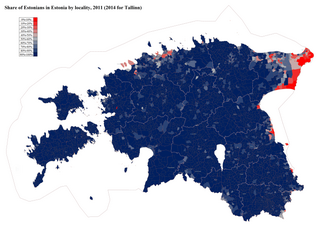
In Estonia, the population of ethnic Russians is estimated at 306,801, most of whom live in the capital city Tallinn and other urban areas of Harju and Ida-Viru counties. While a small settlement of Russian Old Believers on the coast of Lake Peipus has an over 300-year long history, the large majority of the ethnic Russian population in the country originates from the immigration from Russia and other parts of the former USSR during the 1944–1991 Soviet occupation of Estonia.
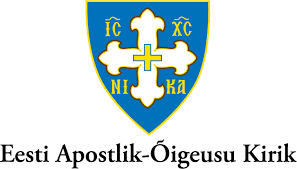
The Estonian Apostolic Orthodox Church is an Orthodox church in Estonia under the direct jurisdiction of the Ecumenical Patriarch of Constantinople. Under Estonian law it is the legal successor to the pre–World War II Estonian Orthodox Church, which in 1940 had over 210,000 faithful, three bishops, 156 parishes, 131 priests, 19 deacons, two monasteries, and a theological seminary; the majority of the faithful were ethnic Estonians. Its official name is the Orthodox Church of Estonia.
The Communist Party of Estonia was a political party in Estonia. The party was founded in 1920, functioned as the republican-level organization of the Communist Party of the Soviet Union in the Estonian SSR 1940-1990.
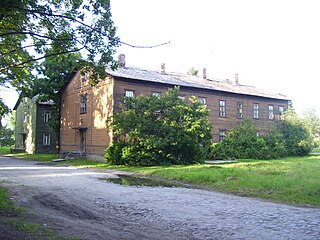
Kopli is a subdistrict of the district of Põhja-Tallinn in Tallinn, the capital of Estonia. It is located on the Kopli Peninsula and is bordered by parts of the Tallinn Bay, the Kopli Bay to the southwest and the Paljassaare Bay to the north. Kopli has a population of 7,240. Kopli's former German name until 1918 was Ziegelskoppel.

The Popular Front of Estonia, introduced to the public by the Estonian politician Edgar Savisaar under the short-lived name Popular Front for the Support of Perestroika, was a political organisation in Estonia in the late 1980s and early 1990s. Edgar Savisaar introduced the idea of popular front during a TV show on 13 April 1988. The idea was developed through the year and finally The Estonian Popular Front was established on 1 October 1988 with a massively crowded congress which turned to a culmination of the first phase of the Singing Revolution.
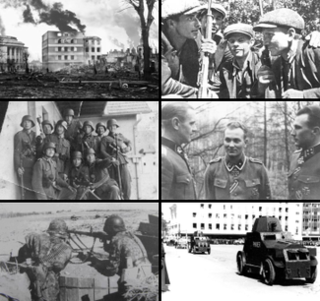
Estonia declared neutrality at the outbreak of World War II (1939–1945), but the country was repeatedly contested, invaded and occupied, first by the Stalinist Soviet Union in 1940, then by Nazi Germany in 1941, and ultimately reinvaded and reoccupied in 1944 by the Soviet Union.

Paide Linnameeskond is a professional football club based in Paide, Estonia that competes in the Meistriliiga, the top flight of Estonian football. The club's home ground is Paide linnastaadion.
Prostitution in Estonia is legal in itself, but organized prostitution is illegal. Since prostitution is a sensitive indicator that develops with changes in the social environment and the state, it is useful to divide the history of this phenomenon from Estonia's first independence according to the different historical stages of the country.

The Estonian Soviet Socialist Republic, also known as the Estonian SSR, Soviet Estonia, or simply Estonia, was a union republic and an ethnically based administrative subdivision of the former Soviet Union (USSR) covering the occupied and annexed territory of Estonia in 1940–1941 and 1944–1991. The Estonian SSR was nominally established to replace the until then independent Republic of Estonia on 21 July 1940, a month after the 16–17 June 1940 Soviet military invasion and occupation of the country during World War II. After the installation of a Stalinist government which, backed by the occupying Soviet Red Army, declared Estonia a Soviet constituency, the Estonian SSR was subsequently incorporated into the Soviet Union as a "union republic" on 6 August 1940. Estonia was occupied by Nazi Germany in 1941, and administered as a part of Reichskommissariat Ostland until it was reconquered by the USSR in 1944.
Latvian Riflemen Soviet Divisions were military formations of the Red Army during World War II created in 1941 and consisting primarily of ethnic Latvians.
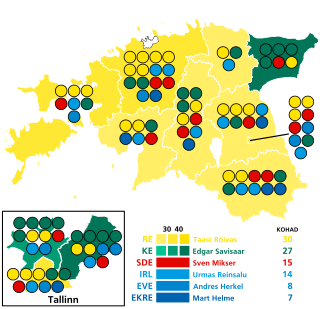
Parliamentary elections were held in Estonia on 1 March 2015. Advance voting was held between 19 and 25 February with a turnout of 33 percent. The Reform Party remained the largest in the Riigikogu, winning 30 of the 101 seats. Its leader, Taavi Rõivas, remained Prime Minister. The newly elected 101 members of the 13th Riigikogu assembled at Toompea Castle in Tallinn within ten days of the election.